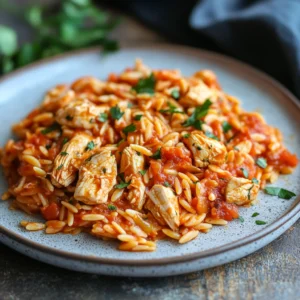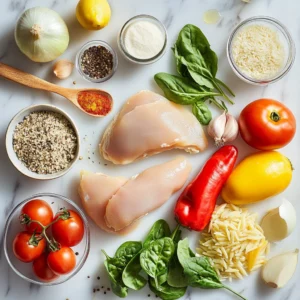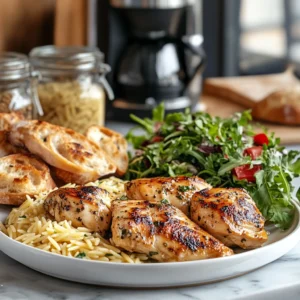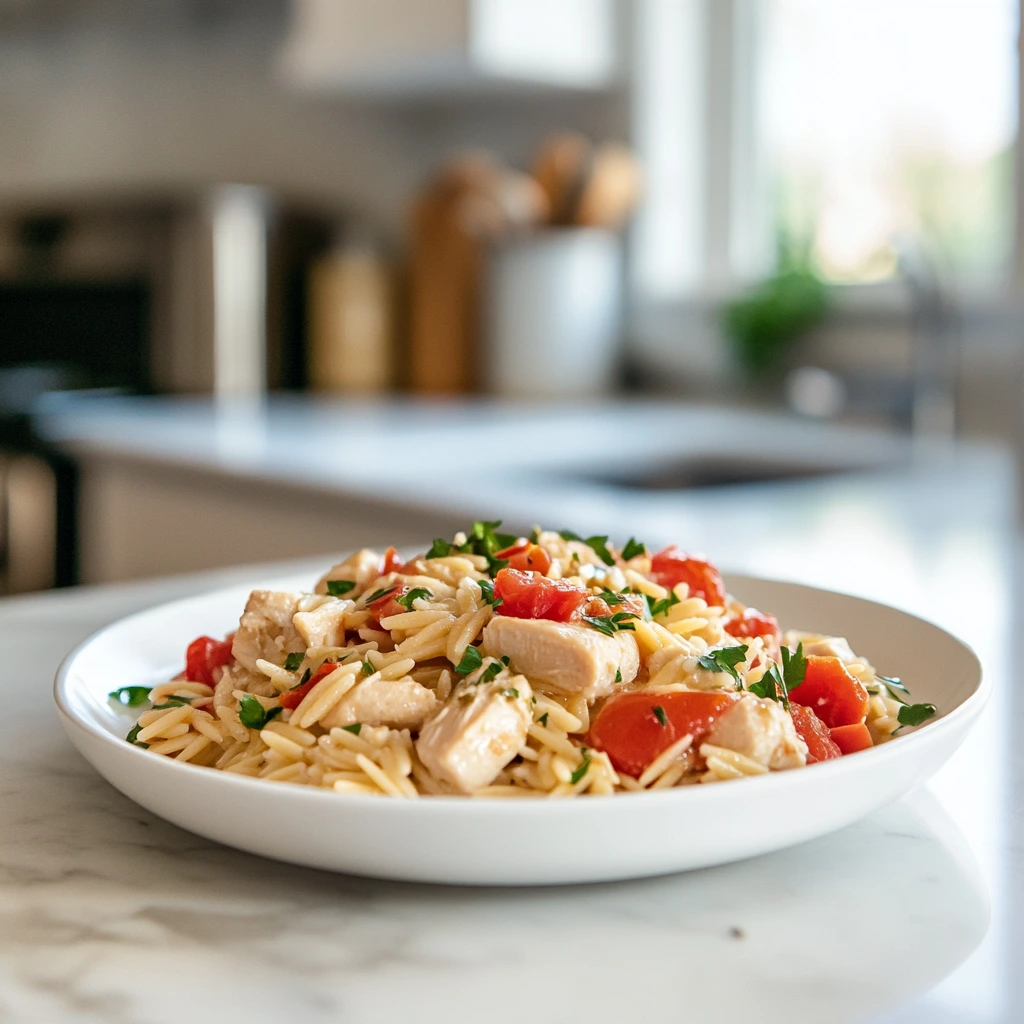Discover a versatile, comforting, and delicious chicken orzo recipe that brings together tender chicken, perfectly cooked orzo, and a medley of fresh vegetables and herbs in one satisfying, one-pot meal. This article provides a step-by-step guide, cooking tips, nutritional insights, and serving suggestions to help you create a meal that not only warms your heart but also pleases your palate. Whether you’re a busy professional or a passionate home cook, this guide offers practical advice and culinary inspiration.
Table of Contents
Introduction and Background
The chicken orzo recipe is a classic dish that beautifully marries the succulence of chicken with the delightful texture of orzo pasta. Originating from Mediterranean influences, this one-pot meal has evolved into a family favorite across kitchens worldwide. In this article, we explore:
- The origins of orzo and its culinary journey.
- Why chicken remains a top protein choice.
- How the combination of these ingredients creates a balanced, flavorful dish.
The simplicity of a one-pot meal is a significant draw, and this recipe is ideal for those looking for a nutritious, convenient dinner option. As you read, you’ll discover not only how to prepare this meal but also tips to tweak it according to your taste preferences.
Nutritional and Health Benefits
A well-balanced meal should be both delicious and nutritious. Here’s why this chicken orzo recipe stands out:
- Rich in Protein: Chicken provides essential proteins that help build and repair tissues.
- Complex Carbohydrates: Orzo offers a source of energy that is slowly digested.
- Vitamins and Minerals: The fresh vegetables and herbs contribute vitamins, antioxidants, and fiber.
- Low-Calorie Option: When prepared with lean ingredients, this dish is perfect for a healthy lifestyle.
For additional information on the benefits of a Mediterranean diet, visit EatRight.org’s Mediterranean Diet Guide.
Recipe Variations and Customizations

The beauty of this chicken orzo recipe lies in its adaptability. Consider these variations and customization tips:
- Creamy vs. Tomato-Based Sauces:
- Creamy Version: Add a splash of cream or Greek yogurt for a richer sauce.
- Tomato-Based Version: Use crushed tomatoes to create a vibrant, tangy flavor.
- Vegetarian Twist:
- Substitute chicken with tofu or a mix of your favorite vegetables.
- Spice It Up:
- Experiment with spices like paprika, cumin, or red pepper flakes.
- Gluten-Free Option:
- Replace orzo with a gluten-free pasta alternative.
- Extra Veggies:
- Enhance the nutritional profile with spinach, bell peppers, or zucchini.
These options allow you to tailor the recipe to your dietary needs and flavor preferences while keeping the core essence of a comforting one-pot meal.
Ingredients and Preparations

Before you begin, gather all necessary ingredients and prepare your ingredients for a smooth cooking process. Below is a detailed list:
- Proteins:
- Chicken thighs or breasts (skinless, boneless)
- Pasta:
- Orzo pasta
- Vegetables:
- Diced onions, bell peppers, tomatoes, spinach, and garlic
- Herbs and Spices:
- Fresh basil, thyme, oregano, salt, pepper, and red pepper flakes
- Liquids:
- Chicken broth and olive oil
- Optional Additions:
- Lemon zest, grated Parmesan cheese, and a touch of cream
Preparation Tips
- Marinate the Chicken:
- Season the chicken with salt, pepper, and your choice of herbs for at least 30 minutes.
- Pre-Chop Vegetables:
- Dice all vegetables uniformly to ensure even cooking.
- Measure Ingredients:
- Prepare all ingredients on a clean countertop before you start the cooking process.
Using bullet points to organize your preparation tasks not only keeps you organized but also makes the cooking process efficient.
Equipment and Setup
Having the right equipment is key to executing this chicken orzo recipe successfully. You will need:
- Large Skillet or Dutch Oven: Ideal for one-pot cooking.
- Measuring Cups and Spoons: For precise ingredient measurements.
- Sharp Knife and Cutting Board: Essential for dicing vegetables and chicken.
- Wooden Spoon or Spatula: For stirring and mixing ingredients evenly.
A clean and well-organized kitchen setup will help streamline the cooking process and ensure that each step is executed perfectly.
Step-by-Step Cooking Instructions
Prepping the Chicken
- Seasoning and Marinating:
- Coat the chicken evenly with salt, pepper, and a mix of herbs such as thyme, oregano, and a pinch of red pepper flakes.
- Allow the chicken to marinate for at least 30 minutes to absorb the flavors.
- Searing the Chicken:
- Heat olive oil in a large skillet or Dutch oven over medium-high heat.
- Place the chicken in the pan and sear until each side is golden brown, locking in juices and creating a beautiful crust.
- Resting the Chicken:
- Once seared, remove the chicken temporarily to allow for further cooking steps.
Key tip: Searing not only enhances flavor but also ensures the chicken remains moist throughout the cooking process.
Cooking the Orzo
- Toasting the Orzo:
- In the same pan, add a small drizzle of olive oil if needed.
- Add the orzo pasta and toast for 2–3 minutes until it begins to turn a light golden color.
- Bullet Points:
- Improves flavor by releasing the pasta’s natural nutty aroma.
- Helps the pasta maintain texture during simmering.
- Boiling the Orzo:
- Gradually pour in the chicken broth while stirring continuously to prevent sticking.
- Cook until the pasta reaches an al dente consistency.
Combining Ingredients
- Reintroducing the Chicken:
- Return the seared chicken to the pot and mix well with the toasted orzo and broth.
- Adding Vegetables and Herbs:
- Add diced onions, garlic, bell peppers, and tomatoes.
- Stir in fresh spinach and basil at the end to preserve their vibrant color and flavor.
- Bullet Points:
- Onions and garlic provide a foundational flavor base.
- Spinach and basil add a burst of freshness.
- Simmering:
- Lower the heat and allow the dish to simmer for 10–15 minutes.
- Ensure the chicken is thoroughly cooked and the orzo has absorbed all the liquid.
- Season with additional salt and pepper if needed.
Finishing Touches and Garnishing
- Final Garnish:
- Just before serving, add a touch of lemon zest for brightness.
- Sprinkle freshly grated Parmesan cheese over the dish.
- Drizzle a little extra virgin olive oil for added richness.
- Presentation:
- Plate the dish in a deep bowl or on a serving platter.
- Garnish with additional fresh herbs such as chopped basil or parsley.
These finishing touches elevate the dish, providing both visual appeal and an extra burst of flavor that complements the chicken orzo recipe perfectly.
Tips, Tricks, and Chef’s Advice
Elevate your cooking experience with these practical tips:
- Avoid Overcooking:
- Monitor the chicken and orzo during simmering to prevent dryness or mushiness.
- Layering Flavors:
- Build flavor by searing the chicken first, then deglazing the pan with broth. This technique releases the browned bits from the bottom, infusing the dish with extra depth.
- Time-Saving Techniques:
- Prepare the vegetables and marinate the chicken in advance.
- Storing Leftovers:
- Store extra portions in an airtight container in the refrigerator. Reheat slowly over low heat to preserve flavor and texture.
- Experiment with Variations:
- Consider trying a tomato-based version or adding different seasonal vegetables for variety.
For additional insights on maximizing leftovers, check out our guide on leftover rotisserie chicken recipes.
Serving Suggestions and Pairings

A beautifully plated dish can transform a simple meal into an experience. Consider these serving suggestions:
- Presentation Tips:
- Use a large, shallow bowl to display the vibrant colors of the dish.
- Garnish with a sprinkle of fresh herbs and a drizzle of high-quality olive oil.
- Side Dishes:
- Serve with a crisp green salad or a side of steamed vegetables.
- Pair with crusty bread or garlic toast for an extra layer of texture.
- Beverage Pairings:
- Enjoy with a light white wine alternative such as a non-alcoholic beverage or a refreshing tropical smoothie.
- Occasions:
- Ideal for family dinners, casual gatherings, or even a special date night.
For a refreshing drink option, explore our tropical smoothie recipe.
Troubleshooting Common Issues
Even the best recipes can encounter challenges. Here are some quick fixes:
- Overcooked Chicken:
- If your chicken becomes dry, consider slicing it thinly and mixing it back into the dish with a bit of extra broth.
- Mushy Orzo:
- Prevent this by monitoring the liquid absorption closely. Under-cooked orzo can be remedied by adding a splash more broth.
- Flavor Imbalance:
- Adjust seasonings gradually. A squeeze of lemon juice or a pinch more salt can restore balance.
Quick Troubleshooting Tips:
- Check internal temperatures to ensure proper cooking.
- Stir frequently to avoid sticking and burning.
- Taste as you go to fine-tune the flavor profile.
For more on combining spices effectively, our comprehensive guide to combining spices can offer additional insights.
FAQs
What is the best type of chicken to use in this recipe?
- Answer: Bone-in, skinless chicken thighs provide extra flavor, though boneless breasts can work well for a leaner option. Ensure the pieces are similar in size for even cooking.
Can this chicken orzo recipe be made ahead of time?
- Answer: Yes, you can prepare it in advance. Store in an airtight container in the refrigerator and gently reheat over low heat. This dish is even better the next day as flavors meld.
How can I adapt the recipe for a gluten-free diet?
- Answer: Substitute traditional orzo with a gluten-free pasta variety. Ensure all other ingredients, such as broth and spices, are also gluten-free.
What variations can I try with this chicken orzo recipe?
- Answer: Experiment with a tomato-based sauce, add extra vegetables, or try a creamy version by incorporating a small amount of cream or Greek yogurt.
Conclusion and Call to Action
In summary, this chicken orzo recipe is a delicious, adaptable, and nutritious option that can easily become a staple in your weekly meal plan. With tender chicken, perfectly cooked orzo, and a burst of fresh flavors, this dish offers something for everyone. We encourage you to try this recipe, experiment with the variations, and share your experience. Remember, the key to a great dish is always in the details—whether it’s the perfect sear on your chicken or the ideal texture of your orzo.
For more creative and inspiring recipes, check out BBC Good Food.
Feel free to share your thoughts and any modifications you made to this recipe in the comments below or on social media. Happy cooking!

